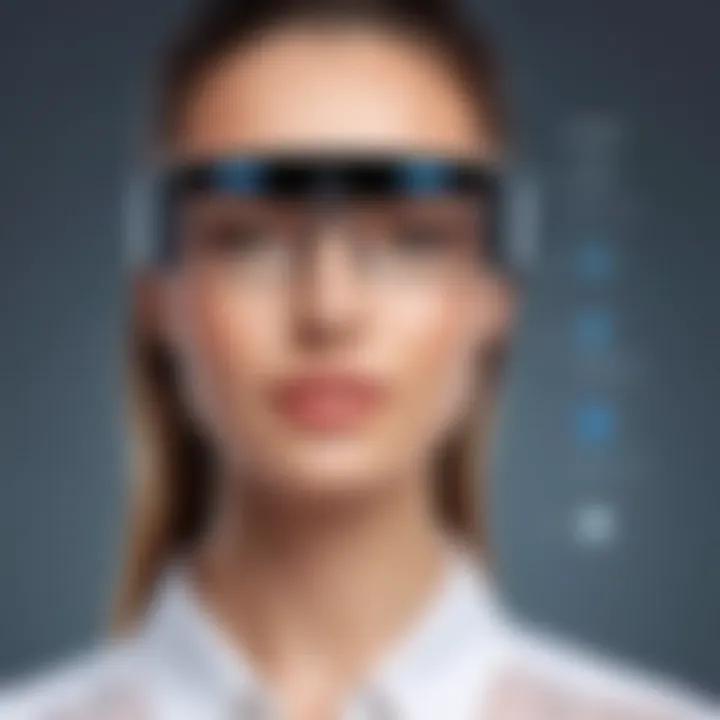Exploring Eufy Facial Recognition Technology


Intro
In today's increasingly connected world, facial recognition technology plays a pivotal role in enhancing security and improving user experience. Eufy, a brand known for its smart home devices, has integrated this technology into its product lineup. This article explores the technical specifications, functionalities, advantages, and limitations of Eufy facial recognition technology. The narrative will provide a comprehensive guide to understanding how such features can enhance home security and impact personal privacy.
As we dive deeper, we will analyze user experiences, discuss ethical considerations, and look at the potential future of facial recognition within the smart home ecosystem, ensuring a well-rounded perspective on this significant development. With the rise of smart technologies, it is essential to grasp not only how they function but also what they mean for the consumers that use them.
Technical Specifications
Detailed Product Specs
Eufy facial recognition technology can be found in products like Eufy Security Smart Video Doorbell and Eufy Indoor Cam. These devices often come equipped with high-resolution cameras, infrared night vision, and advanced image processing capabilities that allow them to accurately identify faces.
Typically, these cameras boast:
- Resolution: 1080p or higher for clear image capture
- Field of View: Wide-angle lens to cover more area
- Night Vision: Infrared technology for low-light conditions
Performance Metrics
When evaluating Eufy’s facial recognition accuracy, several metrics are noteworthy. These include:
- Recognition Speed: How quickly the device identifies a face, usually within a second.
- False Acceptance Rate: Low rates signify the system’s reliability in avoiding incorrect identifications.
- User Feedback: Reviews often highlight device responsiveness and accuracy in various environments.
Compatibility Information
Eufy facial recognition devices are designed to work seamlessly with other smart home systems. They are compatible with Eufy Security app, which allows users to manage their devices from a single interface. Integration with platforms like Amazon Alexa and Google Assistant enhances their functionality, giving users more control and convenience.
In summary, understanding the technical specifications behind Eufy’s facial recognition technology is essential for making informed decisions about its use in enhancing home security. The balance of performance metrics and compatibility ensures that users can trust these products to augment their smart home experiences.
Preface to Eufy Facial Recognition
Facial recognition technology is increasingly becoming a part of our daily lives, particularly in the domain of home security. Eufy, a prominent brand in smart home solutions, leverages this technology to provide enhanced security features in its product lineup. Understanding how Eufy's facial recognition works and its implications can help consumers make informed decisions about their home security.
Eufy’s facial recognition is not just about identifying faces; it is about creating a secure environment through innovation. This technology enables devices to distinguish between known individuals and strangers. Users benefit from receiving alerts about who is at their door or nearby, thus enhancing their situational awareness.
Adoption of facial recognition can also simplify everyday interactions with technology. Homeowners can set up Eufy devices to recognize family members, improving convenience while ensuring security. This balance between protection and user-friendliness is crucial in promoting broader acceptance of such systems.
However, as with any technology, there are considerations to keep in mind. Questions about privacy, data storage, and ethical implications emerge with the integration of facial recognition in smart devices. Consumers need to weigh the benefits of added security against potential risks to their personal information.
This article will explore various dimensions of Eufy’s facial recognition, analyze its technology, advantages, and limitations, and examine real-world user experiences. By doing so, it aims to provide clarity on how Eufy fits into the larger narrative of smart home security.
Understanding Facial Recognition Technology
Facial recognition technology is a significant topic in today's digital landscape. It provides unique advantages in security and convenience. Understanding its foundations is crucial, particularly when evaluating products like those offered by Eufy. This section will explore key elements such as the technology's effectiveness, its applications, and considerations linked to its use.
This technology relies on pattern recognition to identify individuals. With the increase in smart home devices, integrating facial recognition can enhance security measures significantly. Users can experience a higher sense of safety, knowing that their devices can discern familiar faces and react accordingly.
Basics of Facial Recognition
Facial recognition involves capturing an image of a person's face and processing it through complex algorithms. Initially, the system detects facial features and compares these to a database. The foundational aspects include:
- Image Acquisition: A camera captures an image or a video stream of a person's face.
- Face Detection: The software identifies and isolates faces within the image.
- Feature Extraction: Essential facial features, such as the distance between eyes or the shape of the jawline, are measured and digitized.
- Recognition: The distinct features are then compared against a stored database.
Each phase is essential for achieving accurate results. Accurate facial recognition systems can potentially minimize false positives, enhancing user trust.
How Facial Recognition Works
The mechanics of facial recognition involve sophisticated techniques. Here are the primary steps in the functioning of the technology:
- Image Processing: First, the acquired image undergoes processing, where noise and inconsistencies are reduced.
- Face Mapping: The system identifies key markers on the face, mapping locations such as eyes, nose, and mouth.
- Database Comparison: Retrieved features compare with stored data, identifying potential matches through algorithms.
- Response Triggering: Upon recognition, the system can trigger specific responses, such as unlocking doors or sending alerts.
"Facial recognition technology hinges on advanced algorithms for reliable identification and authentication."
Overall, the understanding of facial recognition technology is crucial as it determines the effectiveness of systems designed for security and convenience in smart home environments. It goes beyond mere identification to questions of privacy, data security, and ethical use.
Eufy’s Implementation of Facial Recognition
Eufy’s application of facial recognition technology stands out in the current landscape of home security. This implementation not only enhances the efficiency of their devices but also elevates the user experience significantly. By incorporating advanced algorithms and intuitive design, Eufy has prioritized both usability and functionality. The benefits are manifold, ranging from improved security measures to convenient user interactions, making it an essential topic for anyone considering smart home technology.


Device Overview
Eufy Security Cameras
Eufy Security Cameras have emerged as a pivotal element in home monitoring. One specific aspect is their ability to utilize facial recognition to distinguish between known individuals and intruders. This key characteristic is critical as it allows users to receive alerts tailored to their specific needs. Unlike traditional cameras, Eufy uses machine learning to improve over time, adapting to the faces in its database.
A unique feature of these cameras is their ability to function even in low-light conditions while maintaining clear image quality. This enhances the overall security experience by ensuring reliable performance, regardless of the time of day. However, it is essential to acknowledge that occasional misidentifications can occur, particularly with changes in appearance or accessories, which can be a drawback for some users.
Eufy Smart Doorbells
Eufy Smart Doorbells represent another significant facet of the company’s facial recognition implementation. These doorbells allow users to identify visitors before opening the door, providing enhanced safety. The standout characteristic of Eufy Smart Doorbells is their two-way audio feature, allowing communication with visitors without needing to be present at the door.
The unique capability of detecting familiar faces enhances the security level, as it sends customized notifications based on who is at the door. One potential disadvantage could be the dependency on a consistent internet connection for optimal functionality, which might affect usability in areas with poor network coverage.
Technical Specifications of Eufy Facial Recognition
Algorithm Efficiency
The algorithm efficiency of Eufy’s facial recognition technology plays a vital role in its effectiveness. It is designed to deliver real-time analysis, ensuring quick identification of individuals. This efficiency is a key characteristic that sets it apart in the market, as many devices may experience delays in recognition.
A unique feature of Eufy's algorithm is its capacity to learn from interactions, continually refining and optimizing its recognition accuracy. While this offers substantial advantages, it also means that the system requires an initial training period, where accuracy may not be as high until the database of known faces is sufficiently populated.
Storage Capacity
Storage capacity is another crucial aspect of Eufy’s implementation. The devices come with considerable local storage options, allowing users to retain video footage without relying solely on cloud storage. This independence enhances privacy, minimizing concerns about data security in external servers.
The unique feature of expandable storage options grants flexibility to users, enabling them to customize their setup as needed. However, the limitation of local storage could pose challenges if users exceed capacity, leading to the need for regular management of saved footage.
"Incorporating these technical specifications underlines the ongoing commitment of Eufy to refine their products and adapt to user needs."
By understanding these facets of Eufy’s facial recognition technology, the benefits and limitations become clear. The thoughtful integration of advanced functionalities, such as enhanced algorithm efficiency and reliable storage capacity, contributes to a comprehensive security system that aligns with the present needs of tech-savvy consumers and everyday users alike.
Advantages of Eufy Facial Recognition
The advantages of Eufy facial recognition are crucial for understanding its role in modern home security systems. By leveraging advanced technology, Eufy products offer significant enhancements to personal safety and everyday convenience. These advantages become even more relevant in a world increasingly aware of the need for effective security solutions. A closer look reveals specific elements that standout in Eufy’s implementation of this technology, emphasizing both security and user benefits.
Enhanced Security Features
Eufy facial recognition technology plays a vital role in improving security for homes. The ability to accurately identify known individuals against unwanted intruders is a primary feature. This system prevents unauthorized access, thereby enhancing overall home safety. Eufy cameras, equipped with this technology, utilize sophisticated algorithms to efficiently compare live images against a stored database of faces. The added layer of security is particularly valuable for families and individuals who prioritize safeguarding their living spaces.
One important aspect is the instant alerts sent to users' mobile devices whenever an unfamiliar face is detected. This feature allows homeowners to act swiftly in response to potential threats. Additionally, the smart recognition capabilities mean that users can customize their experience by allowing or denying access to certain individuals. Such precision in security not only contains potential risks but also provides peace of mind, knowing that the system can discern between friends and strangers.
User Convenience
In addition to security improvements, Eufy facial recognition heightens user convenience significantly. The nterface is designed with simplicity in mind, enabling effortless navigation for users of all levels. Facial recognition permits seamless access control; for instance, when a recognized person approaches, the door can automatically unlock without manual intervention. Such automation is particularly helpful in situations where hands might be full, such as carrying groceries or managing children.
Moreover, the easy integration of Eufy's facial recognition with other smart home devices provides an enhanced user experience. Smart routines can be established, where lights turn on as recognized individuals enter, or certain appliances activate automatically, adapting to different user preferences. This kind of adaptability simplifies the use of technology at home. Users can spend less time fiddling with devices and more time enjoying the comfort of their environment.
The blend of security and convenience presents Eufy's facial recognition as not just a safety measure, but also a lifestyle enhancement.
Limitations of Eufy Facial Recognition
Understanding the limitations of Eufy facial recognition is crucial for evaluating the efficacy of its products. While Eufy offers advanced features in home security, recognizing these limitations helps consumers make informed decisions.
Accuracy Issues
The accuracy of Eufy’s facial recognition technology can vary depending on several factors. While marketed as a reliable solution for identifying friends and family, the system may struggle with misidentifying individuals. This problem can stem from several causes, such as poor camera angles, inadequate lighting, or facial obstructions like masks and sunglasses. In some cases, similar-looking individuals may be mistakenly identified due to the algorithm’s limitations in distinguishing facial features.
For instance, studies have shown that certain models of Eufy cameras have faced challenges in distinguishing between similar faces or even within the same household where people may have similar characteristics. This leads to concerns about security, especially in scenarios where precise identification is critical. At times, users report receiving notifications for unauthorized persons that are actually trusted visitors. Users need to verify the identity manually, reducing the efficacy of the technology.
Environmental Factors
Environmental conditions significantly influence the performance of Eufy facial recognition technology. Factors such as lighting, weather, and physical obstructions can limit the camera’s ability to capture clear images for processing.
In poorly lit environments, for example, the camera may not excel in facial recognition. Low light can cause grainy images which hinder the algorithm’s performance in accurately recognizing faces. Also, extreme weather conditions, like heavy rain or snow, could obscure the camera lens, rendering the system less effective.
Additionally, the placement of the cameras can affect their functionality. Mounting them too high or at awkward angles can obscure the field of vision, diminishing the technology's capacity to function optimally. Users should consider these factors when integrating Eufy devices into their home security systems.


"Recognizing the constraints of facial recognition is essential for improving user experience and system reliability."
In summary, while Eufy’s facial recognition technology offers numerous advantages, users must remain mindful of its limitations. Accuracy issues and environmental factors are key areas that may affect its overall effectiveness. Consumers should weigh these considerations when investing in Eufy products for home security.
User Experiences and Case Studies
User experiences and case studies are vital for comprehending the practical implications of Eufy's facial recognition technology. They provide insight into how the technology performs in real-world scenarios and can highlight both its advantages and drawbacks. With a deeper understanding of user experiences, potential buyers can make informed decisions regarding the adoption of Eufy products. Moreover, case studies often reveal trends and common issues faced, shedding light on areas where the technology excels or needs improvement.
Positive User Feedback
Many users of Eufy facial recognition systems praise the ease of use and efficiency of the technology. The quick setup process is often mentioned, as most devices are designed to work out of the box with minimal configuration. Users appreciate that the interface is intuitive, which is important for those who might not be tech-savvy.
The accuracy of the facial recognition feature is another highlight in positive reviews. Users report that Eufy's technology quickly learns the faces it encounters and can distinguish between family members and strangers effectively. This functionality plays a key role in enhancing home security, as it minimizes false alarms and allows for tailored alerts based on recognized individuals.
Additionally, satisfied customers often note that the integration with other smart home devices is seamless. They mention using Eufy's products in conjunction with their smart ecosystems, enhancing the overall user experience. Being able to receive notifications on their smartphones or through other means keeps users informed, allowing for proactive responses to potential security threats.
Negative User Feedback
Despite many positive experiences, some users express dissatisfaction with certain aspects of the technology. Common complaints focus on limitations in accuracy under specific conditions, such as low light or when users wear accessories like sunglasses. Instances of misidentification have been documented, leading to concerns about reliability, especially in a scenario where security is paramount.
Another frequent point of criticism involves the dependency on internet connectivity. In cases of weak Wi-Fi signals or outages, users report that the facial recognition feature becomes unreliable. This raises questions about the overall dependability of Eufy products in emergency situations when consistent performance is necessary.
Additionally, data privacy concerns surface in user feedback. Some individuals are uneasy about the amount of data collected through facial recognition technology and how that data is managed. Transparency from companies regarding data practices is crucial for building trust with consumers who are wary of potential misuse of personal information.
"User experiences serve as invaluable testimonials. They highlight the technology's real-world performance, providing a foundational understanding of its implications in daily life."
Integration with Other Smart Home Devices
Integration with other smart home devices is a pivotal aspect of Eufy facial recognition technology. This interoperability not only enhances the user experience but also contributes to a more cohesive smart home ecosystem. As the demand for streamlined automation increases, the ability of Eufy products to communicate and function alongside various smart devices becomes increasingly significant.
Smart home ecosystems typically involve multiple devices, such as security cameras, lighting, and smart locks. Eufy’s facial recognition technology dovetails with these devices to create an efficient security system. For instance, the Eufy Security Cameras can recognize familiar faces. When a person enters the camera’s field, the system can trigger related devices, such as unlocking a smart doorbell or adjusting indoor lighting.
Compatibility with Smart Home Ecosystems
Eufy's facial recognition technology demonstrates strong compatibility with popular smart home platforms. Devices integrate seamlessly with ecosystems like Amazon Alexa and Google Assistant, allowing for voice-controlled operations. This means users can automate responses based on facial recognition events. If someone recognized is at the door, for example, an alert can be sent to the homeowner's mobile device. They can then communicate with the visitor without needing to be physically present.
This compatibility underscores an important feature of Eufy products: their ability to interface with other smart devices. It provides a unified experience that enhances daily routines and reinforces security protocols. Users managing their smart home through Eufy can synchronize alerts, camera feeds, and response actions based on facial recognition outcomes, making these interactions smoother and more intuitive.
Usability Alongside Other Security Features
The integration of Eufy facial recognition technology with other security features adds another layer of usability. It works alongside traditional features such as motion detection and alerts, enhancing situational awareness. For example, if the camera detects movement and identifies a stranger, it can instantly send a notification to the homeowner, providing vital information in real time.
Furthermore, this technology can be configured to allow or deny access based on recognized faces. Users can set specific parameters for different individuals. Family members might enter without any issues, while visitors might need to be approved before gaining entry.
"The significance of seamless interaction between devices cannot be overstated in the smart home arena. Eufy's capacity to meld with other security measures enhances user trust and convenience."
In terms of functionality, Eufy's facial recognition smoothly complements its smart locks and alarm systems. It allows users peace of mind knowing that their entire system operates harmoniously. So, while the Eufy facial recognition technology stands on its own, its strength shines brightly when integrated with other devices.
Privacy Implications of Facial Recognition
Facial recognition technology has become a core part of many security systems today. Eufy, as a notable player in this field, integrates advanced recognition systems into its devices. However, the implications for users’ privacy are significant, raising various concerns. Understanding these implications is critical for consumers who wish to balance security with personal privacy.
Data Collection Practices
Eufy's facial recognition technology relies on the collection and processing of personal data. This process involves gathering images of faces, which are then analyzed to create unique biometric profiles. While this functionality enhances security, it sparks discussions about how this data is stored and used.
- Storage Methods: Data can be stored locally on devices, minimizing exposure to external threats. However, cloud storage facilitates remote access and can increase vulnerabilities.
- Access Control: Who has access to this data? Devices like Eufy security cameras may allow family members or authorized users to manage data access. Users must be aware of these settings to protect their privacy.
- Retention Policies: How long is the data stored? Eufy must be clear about its data retention policies to ensure users understand how their information is managed.
In essence, users must remain vigilant regarding how their biometric data is collected and managed. Awareness of these practices helps consumers make informed decisions about their security devices.
Ethical Considerations
The deployment of facial recognition technology raises ethical questions that go beyond technical capabilities.
- Informed Consent: Users should be made aware when their data is collected and how it will be used. This transparency fosters a sense of trust between consumers and Eufy.
- Bias and Discrimination: There are concerns surrounding the accuracy of facial recognition across different demographics. Algorithm biases can lead to unfair treatment, which is a critical issue for any company involved in this technology.
- Surveillance State Issues: The integration of facial recognition in everyday devices raises concerns about mass surveillance. Users must consider the potential future implications of living under constant observation.
- Data Misuse Risk: There is always the chance that collected data could be misused, either by hackers or by the companies themselves, underscoring the need for robust data protection measures.
"Understanding the ethical landscape of facial recognition technology is vital for companies like Eufy to maintain user trust."


Balancing the benefits of enhanced security with the maintenance of user privacy requires thoughtful consideration. It is crucial for companies like Eufy to address these ethical dilemmas and demonstrate a commitment to responsible data handling. Users must demand transparency and accountability, guiding the future of facial recognition technology within the consumer market.
Future of Facial Recognition in Eufy Products
The future of facial recognition in Eufy products represents a critical juncture in both the evolution of smart home technology and the ongoing discourse surrounding privacy. As technology advances, the integration of more sophisticated facial recognition capabilities can be expected in various Eufy devices. This section discusses these upcoming trends, emphasizing their implications for users and the broader context of smart home security.
Technological Advancements
Eufy is well-positioned to leverage recent breakthroughs in artificial intelligence and machine learning, which can enhance facial recognition accuracy. Innovations in deep learning algorithms are making it possible to process images more quickly and accurately. For example, these modern algorithms utilize neural networks that can learn from vast amounts of data, adapting to changing conditions. This agility may enable Eufy devices to improve their identification accuracy in diverse environments.
In addition, processing power continues to improve with the advancement of chips designed specifically for AI tasks, such as Google's Tensor Processing Units or Apple's Neural Engine. Eufy may adopt similar technologies to enable faster, more refined processing of facial recognition tasks directly on the devices. Doing so would not only improve speed but also enhance data security since fewer images would need to be transmitted to cloud servers.
"Improvements in AI and processing power can revolutionize user interactions with facial recognition technology, making systems like Eufy's more seamless and efficient."
Potential Developments in User Interface
Future updates to Eufy's user interface could greatly enhance how consumers interact with facial recognition features. A more intuitive and user-friendly interface might allow users to manage their facial recognition settings effortlessly. Simplified menus, customizable alerts, and clear visual indicators can empower users to tailor their home security settings according to their preferences.
Moreover, integration capabilities with other smart home devices can be expected to evolve. For instance, users might be able to connect their Eufy facial recognition systems with smart lighting or alarm systems. If a recognized person approaches, the system could trigger specific responses, such as turning on lights or notifying the homeowner directly. This interconnectedness can amplify user experience, making their smart home environment more responsive and intelligent.
In summary, the future of facial recognition in Eufy products is bright. As technology supplies more powerful tools, consumers will benefit from advanced features that enhance security, improve user experience, and address privacy concerns. By anticipatin the possible changes and innovations, users can better understand how to harness the potential of Eufy products in the evolving landscape of smart home technology.
Comparison with Other Brands
In this article, the section on comparing Eufy with other prominent brands is crucial for understanding its place in the market. Consumers often seek assurance that they are making informed choices when it comes to home security. By examining Eufy alongside competitors such as Nest and Ring, readers can grasp essential differences and similarities in features, performance, and user experience. This comparison not only helps potential buyers decide which product suits their needs but also sheds light on industry standards in the realm of facial recognition technology.
Eufy vs. Nest
Eufy and Nest both offer notable smart home solutions with facial recognition capabilities. Nest's offering, primarily through the Nest Hello doorbell and Nest Cam, emphasizes integration with the wider Google ecosystem. This gives Nest a broader range of automated features, such as voice activation through Google Assistant.
On the other hand, Eufy focuses heavily on local storage and privacy, aiming to alleviate concerns about cloud data security. While Nest users might enjoy extensive features, they might also face higher subscription costs due to cloud storage requirements. These costs can accumulate, especially for those with multiple devices. Comparatively, Eufy provides its users with a high degree of autonomy, allowing access to stored data without relying on external servers. This can be appealing for users who are privacy-conscious.
The image recognition algorithms in both brands are equipped to learn and identify familiar faces. However, users have reported that Nest could experience latency in alerts due to reliance on cloud processing. Eufy tends to perform better in real-time scenarios, often sending quicker notifications when recognizing familiar faces.
Eufy vs. Ring
When comparing Eufy to Ring, another major player, the discussion often revolves around usability and feature sets. Ring has gained popularity with its variety of doorbells and security cameras that are deeply integrated with a host of third-party services and smart home systems.
However, Eufy's approach is typically simpler. Ring provides features like Neighbors, which allows users to get real-time crime alerts from their community. This feature adds an element of community awareness but might come at the cost of privacy, as it relies on shared user data. In contrast, Eufy's focus on individual data security promotes a personal safe environment.
In terms of video quality, both Eufy and Ring offer high-definition recording, but Eufy's security cameras often have a slight edge in low-light performance, making it easier for them to capture clear images at night. Additionally, Ring users may find that subscription fees for cloud services to access video history become burdensome, while Eufy prides itself on minimizing ongoing costs by offering free local storage options.
Comparing Eufy with competitors like Nest and Ring provides invaluable insights for consumers. Each brand has its strengths and weaknesses, yet Eufy tends to stand out for those prioritizing local data storage and enhanced privacy.
Consumer Recommendations
When exploring Eufy facial recognition technology, consumer recommendations from current users can greatly aid in making informed choices. These insights often reflect personal experiences, which can provide valuable context beyond specifications and features. Especially in a tech environment populated with options, knowing which products are favored or criticized by real users can guide buyers toward the right decisions.
Which Eufy Products to Consider
Eufy has a range of products integrated with facial recognition capabilities. It's crucial to think about what fits your personal or household requirements. Here are a few noteworthy options:
- Eufy Security Cameras: These tend to offer robust facial recognition for enhanced surveillance. Models like the Eufy Security 2K camera deliver impressive clarity and quick recognition responses.
- Eufy Smart Doorbells: Models such as the Eufy Video Doorbell provide both high-definition video and facial recognition technology. These doorbells can recognize familiar faces, offering notifications and updates tailored to your household.
Each of these products has unique features. Understanding your particular needs—such as security concerns, home layout, and budget—will help in selecting the right item.
Installation and Setup Tips
Successful installation of Eufy devices can greatly influence your overall satisfaction with the product. Here are tips for the most smooth setup:
- Read the Manual First: Always begin by thoroughly reading the installation guide. Eufy products come with detailed manuals that include setup instructions and troubleshooting tips.
- Select Optimal Locations: Consider areas where facial recognition will be most effective. For doorbells, choose a place with a clear view of approaching visitors. Cameras should be set to areas where there is consistent activity.
- Ensure Strong Wi-Fi Connection: Proper functionality often hinges on a strong internet connection. Make sure your Wi-Fi signal is strong in the areas where the devices will be placed.
- Utilize the Eufy Security App: Download and configure the app for real-time control and monitoring. The app will guide you through the setup process with prompts and help manage facial recognition settings.
- Test the Devices: After installation, conduct multiple tests to ensure that facial recognition works effectively. This includes walking in front of the camera, and having family members identified by the system properly.
By completing these steps, users can maximize the advantages of Eufy facial recognition technology, enhancing not only security but also usability within a smart home framework.
Key Takeaways
Key Elements to Consider
- Functionality and Reliability
Eufy facial recognition systems have been designed to distinguish between different individuals effectively. This can prevent unauthorized access and ensure that alerts are triggered only when necessary. Such functionalities directly contribute to both safety and user reassurance. - **User Control and Privacy
With growing concerns about privacy, Eufy focuses on allowing users to manage their data. Users can regularly review and delete recorded footage if they wish. This feature encourages transparency, allowing customers to feel more secure in using smart home technology. - Ease of Integration
Eufy's capacity to integrate with other smart home devices adds a layer of convenience. Users can customize their security systems according to their preferences while enjoying the fruits of interconnected technology. This setup is beneficial for tech-savvy consumers keen on building a highly responsive home environment. - Performance in Variable Conditions
This technology is not without its challenges. Adaptation to different lighting conditions and environmental factors is crucial for reliability. Eufy encompasses such considerations when developing its products. However, aspirants should be privy to the potential limitations that exist in less than ideal conditions.
Advantages of Understanding Key Takeaways
- Informed Decisions: Being well-versed in these key aspects empowers potential users. They can direct their investments toward Eufy products that match their needs while understanding any potential trade-offs.
- Feedback Loop: Knowledge of the strengths and weaknesses of Eufy's facial recognition can also benefit future developments. Users' insights serve as valuable feedback to the company for enhancing technology.
As we encapsulate the essence of Eufy facial recognition technology, the key takeaways cater to an audience seeking comprehension of security technologies. They illustrate that while such systems offer extensive advantages, users must remain conscious of their limitations and ethical implications.







